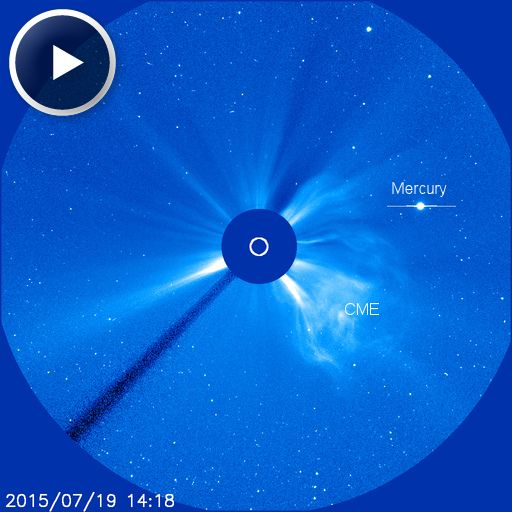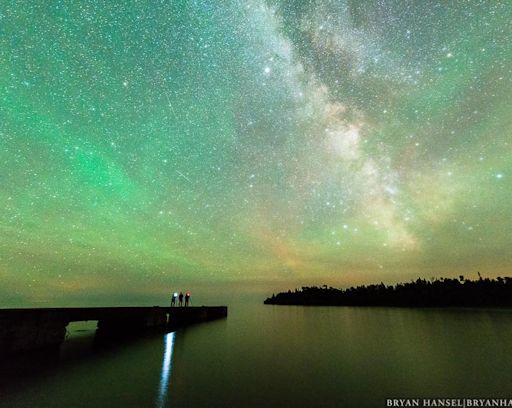Come to Tromsø and share Marianne's passion for rural photography: Chasethelighttours.co.uk invites you to experience "Heaven on Earth" with an aurora, fjord, fishing, whale watching, photography or sightseeing tour. | | | TRANSCONTINENTAL SWx BALLOON LAUNCH--SUCCESS! Earlier today, Spaceweather.com and Earth to Sky Calculus launched two identical Space Weather Balloons, simultaneously, from opposite sides of the USA. The purpose of the experiment was to measure the effect of space weather on Earth's atmosphere across continental scales. Student teams successfully managed both launches--one from the high Sierra mountains of California, the other in the dense-packed forests of southern New Hampshire. Both balloons reached the stratosphere, popped, and the payloads have parachuted safely back to Earth. Stay tuned for images and radiation data. CORONAL MASS EJECTION, INCOMING? A magnetic filament snaking across the sun's southern hemisphere exploded on July 19th (0700 UT), hurling part of itself into space. Soon thereafter, the Solar and Heliospheric Observatory recorded a bright coronal mass ejection (CME) flying away from the sun: 
Although the CME appears to engulf Mercury, it does not. The innermost planet is passing behind the sun millions of miles away from the CME's path. Earth, however, could be in the line of fire. Computer models suggest that the CME could deliver a glancing blow to Earth's magnetic field during the early hours of July 23rd. Polar geomagnetic storms and auroras are possible when the CME arrives. Aurora alerts: text or voice. Realtime Space Weather Photo Gallery NORTHERN SKY TURNS GREEN, NO AURORAS REQUIRED: There was no geomagnetic storm on July 18th, but northern skies turned green anyway. Photographer Bryan Hansel recorded the phenomenon over rural Hovland, Minnesota: 
The green glow was barely visible to the naked eye, but a deep-sky exposure with Hansel's Nikon D800 digital camera captured it easily. This is called "airglow." Although it resembles the aurora borealis, the underlying physics is different. Airglow is caused by an assortment of chemical reactions in the upper atmosphere driven mainly by solar ultraviolet radiation; auroras, on the other hand, are ignited by gusts of solar wind. Green airglow is best photographed from extremely dark sites on nights when the Moon is new or below the horizon. It often shows up in long exposures of the Milky Way. Indeed, the Milky Way was Hansel's actual target. "I run a Milky Way Photography Workshop," he explains."The figures on the dock are three of the photographers in my group and the light is from a camera's LCD screen." Realtime Space Weather Photo Gallery
Realtime Aurora Photo Gallery
Realtime Sprite Photo Gallery
Realtime NLC Photo Gallery. Every night, a network of NASA all-sky cameras scans the skies above the United States for meteoritic fireballs. Automated software maintained by NASA's Meteoroid Environment Office calculates their orbits, velocity, penetration depth in Earth's atmosphere and many other characteristics. Daily results are presented here on Spaceweather.com. On Jul. 20, 2015, the network reported 9 fireballs.
(9 sporadics)  In this diagram of the inner solar system, all of the fireball orbits intersect at a single point--Earth. The orbits are color-coded by velocity, from slow (red) to fast (blue). [Larger image] [movies] Potentially Hazardous Asteroids ( PHAs) are space rocks larger than approximately 100m that can come closer to Earth than 0.05 AU. None of the known PHAs is on a collision course with our planet, although astronomers are finding new ones all the time. On July 20, 2015 there were potentially hazardous asteroids. Notes: LD means "Lunar Distance." 1 LD = 384,401 km, the distance between Earth and the Moon. 1 LD also equals 0.00256 AU. MAG is the visual magnitude of the asteroid on the date of closest approach. | | The official U.S. government space weather bureau | | | The first place to look for information about sundogs, pillars, rainbows and related phenomena. | | | Researchers call it a "Hubble for the sun." SDO is the most advanced solar observatory ever. | | | 3D views of the sun from NASA's Solar and Terrestrial Relations Observatory | | | Realtime and archival images of the Sun from SOHO. | | | from the NOAA Space Environment Center | | | the underlying science of space weather | | | Web-based high school science course with free enrollment | | 
